Even as the shattered hull of the Italian battleship Roma, sunk by German guided bombs, slipped beneath the waves, a vast armada of Allied warships was putting troops ashore to gain a foothold on the Italian mainland. The Germans, desperate to stop the invasion, turned their new weapons on the fleet.
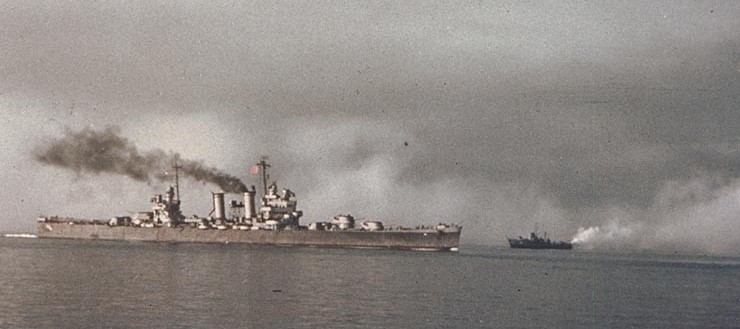
Philadelphia off Salerno
The first sorties against the invasion fleet were flown at dawn on September 11th, two days after it arrived off the beaches. They were flown by aircraft carrying Fritz-Xs, intended to sink the cruisers providing vital fire support for the troops struggling to establish the beachhead. The first target was the Dutch gunboat Flores, which was badly damaged by several near-misses but not sunk. It is likely that they intended to target the nearby cruiser Philadelphia, who was targeted a few hours later by the second Fritz-X sortie. One missed by only 15m, but the ship emerged undamaged.
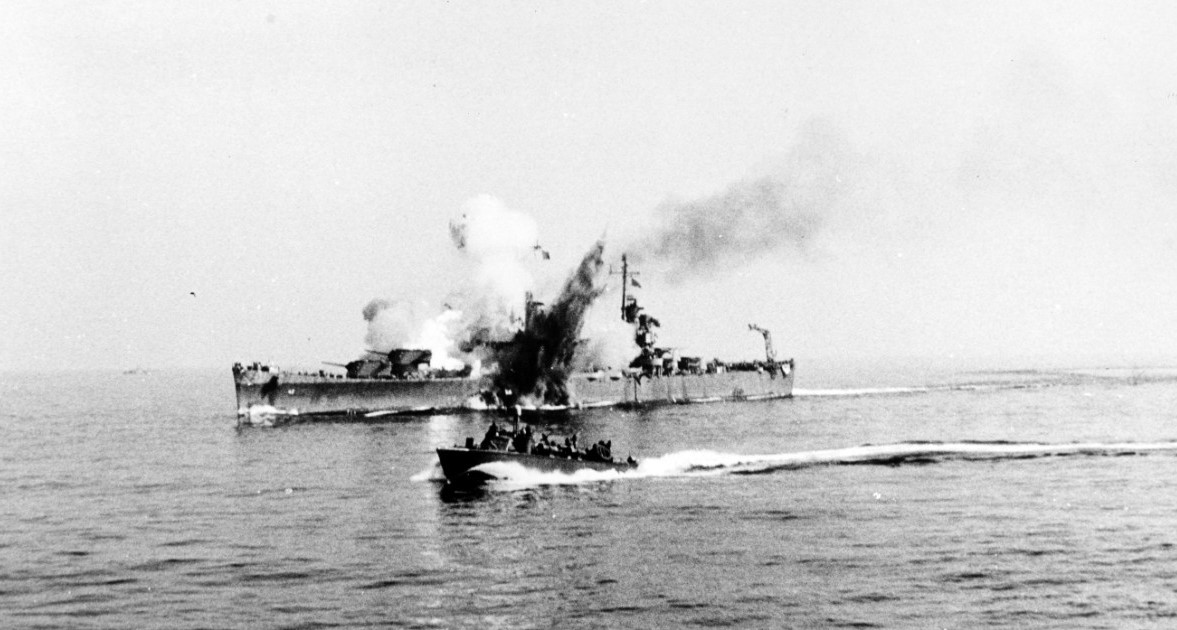
Savannah moments after the bomb hit
Ten minutes later, at 0944, anther Fritz-X was dropped on Philadelphia’s sister ship Savannah. Savannah had been stationary, waiting for the day's fire-support missions, until the raid was detected around 0930. She was accelerating through 20 kts when the bomb struck the top of Turret 3, just in front of her bridge. It easily pierced the 2" plate, and detonated in the 6" handling room deep inside the ship. By all rights, Savannah should have shared Roma’s fate. The blast killed the turret crew and the men in Damage Control Central. Watertight doors connecting to Turrets 1 and 2 were blown open, and their crews suffered heavy casualties from the fumes. The powder within the magazines caught fire, but was extinguished almost immediately by water flooding in through the 300 square foot gash blown in the ship's bottom, which also gave her an 8° list.1 The shock knocked out power throughout the ship, and took all of the boilers offline.2
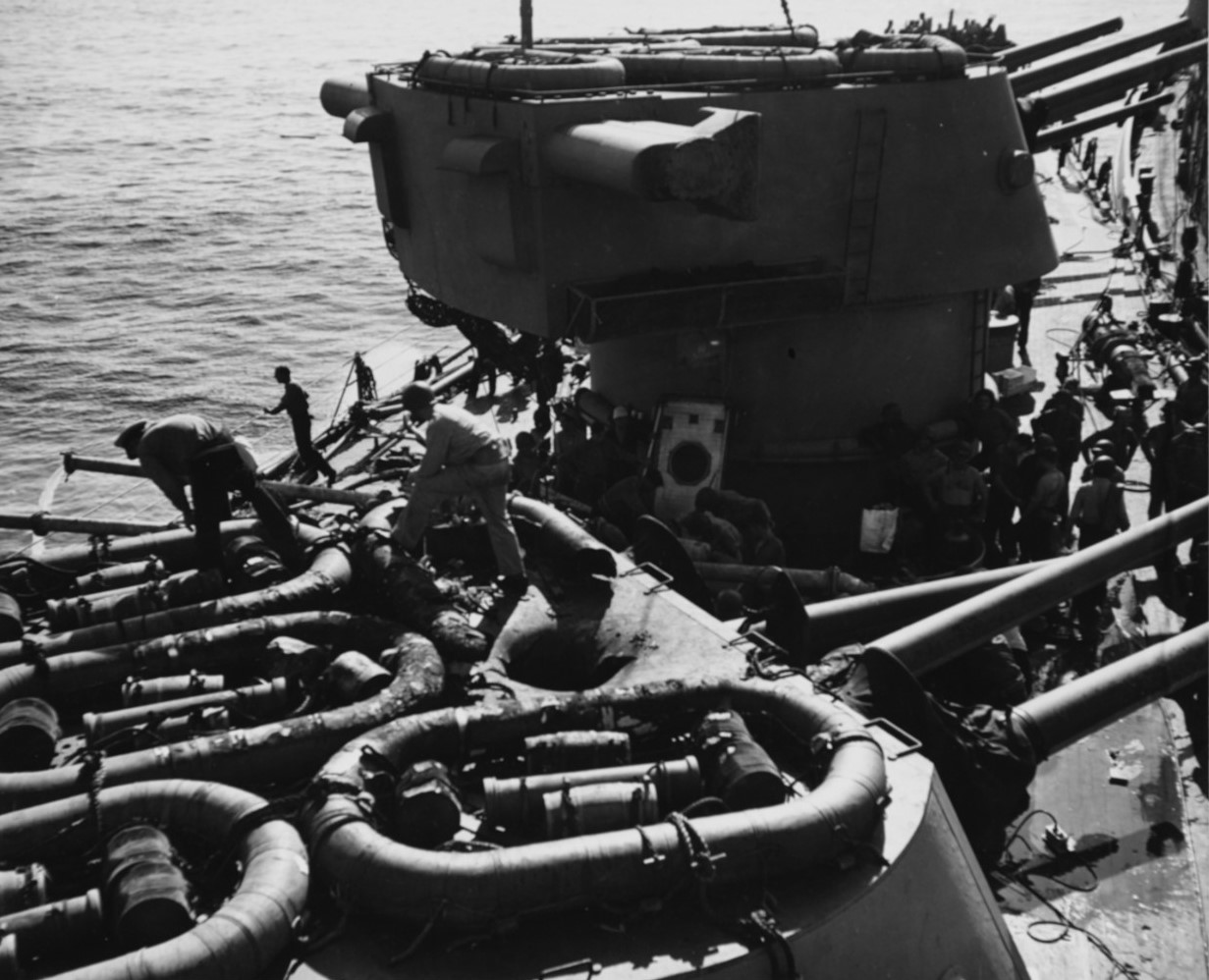
The hole in Turret 3 of Savannah after the fires were put out
Savannah’s crew fought back against the damage, first restoring power and steam, then putting out the fire and establishing flooding boundaries. The salvage tugs Hopi and Moreno came alongside to aid them. Fuel was shifted to keep the ship on an even keel, and by 1800, she was able to depart for Malta under her own steam despite losing 197 of her crew. She eventually made her way back to New York for repair, and the USN took the opportunity to refit the ship with a much better antiaircraft battery.
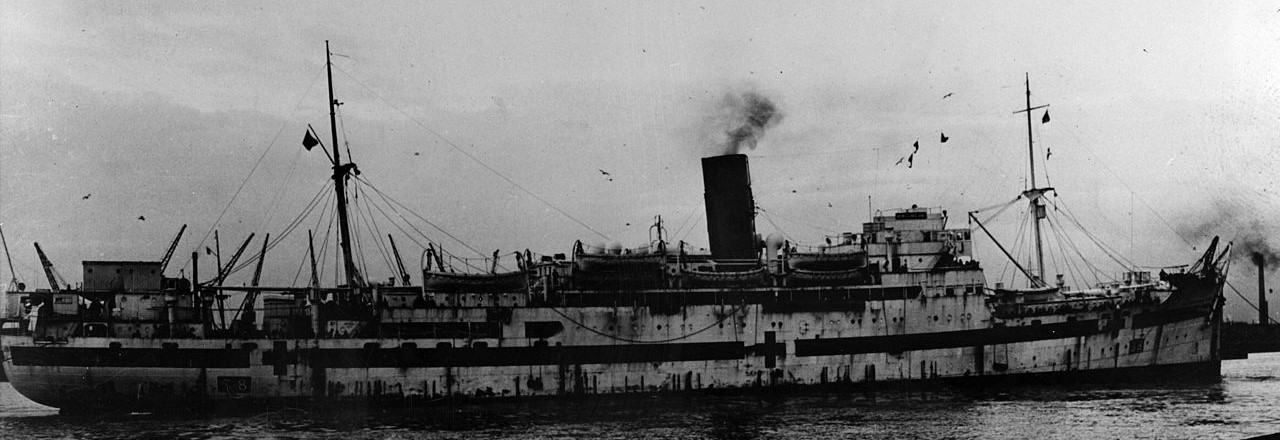
HMHS Newfoundland
Two days later, the Germans reappeared over the beachhead, this time bearing both Hs 293s and Fritz-Xs. Their first victim was the hospital ship Newfoundland, which was attacked by an Hs 293. Fortunately, she was carrying only two patients, but 20 of those aboard her, including six nurses, were killed. The medical facilities were destroyed, and the ship had to be abandoned. The Germans, unlike the Japanese, generally respected the Red Cross, so this attack is rather baffling. Newfoundland was well offshore and brightly lit to reveal her status as a hospital ship, and her loss did not significantly reduce the fighting power of the invasion fleet.
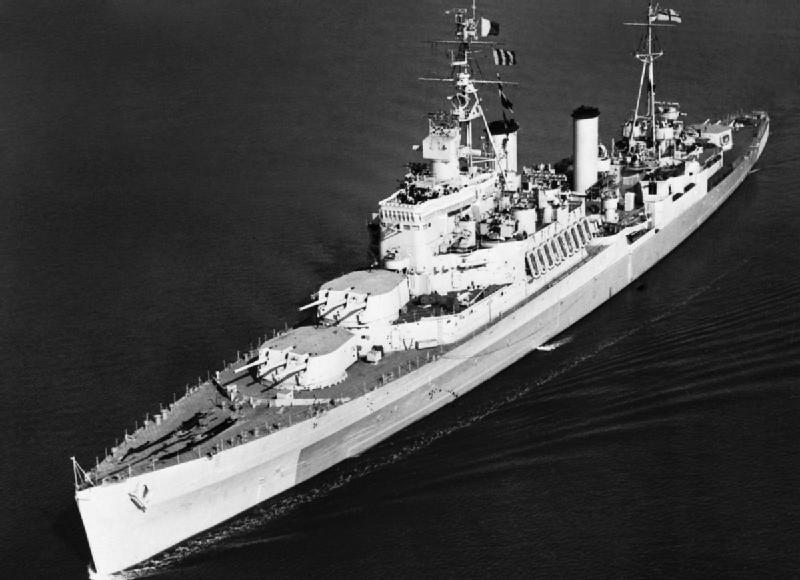
HMS Uganda
That afternoon, Do 217s armed with Fritz-Xs arrived. They first tried to sink Philadelphia again, but missed. Their second attack, on the stationary British cruiser Uganda, was more successful. The bomb penetrated entirely through the ship, exploding under the keel and flooding three of the four engine spaces. The crew managed to keep the ship afloat, and she was towed to Malta. The extensive damage forced her to be sent to the US for a refit lasting until late 1944, when she was transferred to the Royal Canadian Navy and sent to the Pacific.
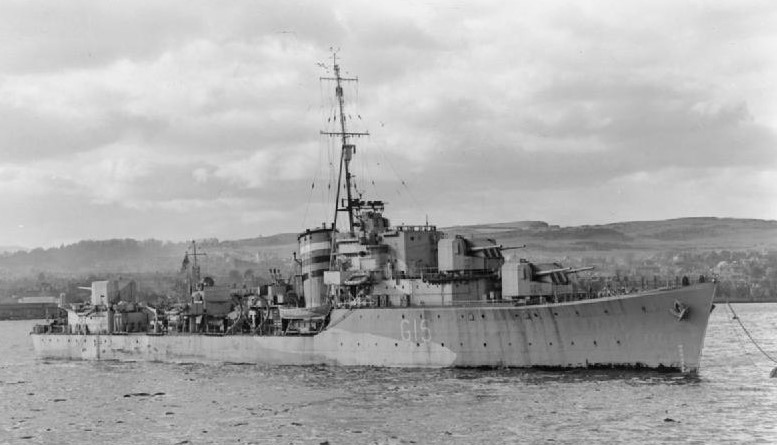
HMS Loyal
An hour later, another group of bombers appeared overhead. They dropped Fritz-Xs on British destroyers Nubian and Loyal and on Philadelphia. However, through a combination of luck and skilled maneuvering, none of them did more than very minor damage to their targets. The next day, an Hs 293 hit the Liberty Ship Bushrod Washington, which was carrying a cargo of gasoline. Despite the heroic efforts of the master, Jonathan Wainwright V, and his crew, Bushrod Washington burned out of control. She had to be abandoned, and exploded the next day.
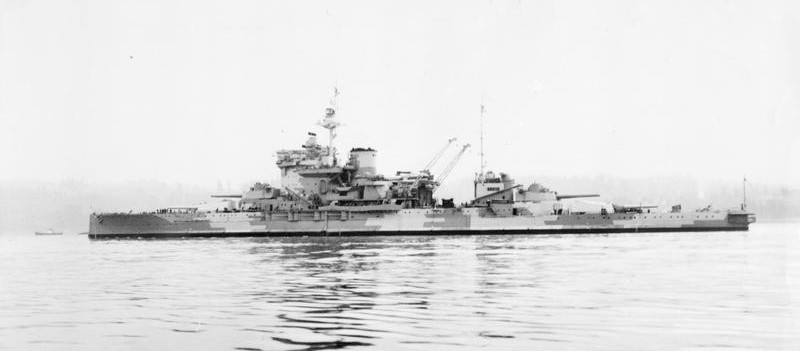
Warspite
On September 16th, the Fritz-X carriers reappeared over Salerno. They targeted the veteran battleship Warspite, recently arrived off the beachhead, and trapped in confined waters. The first bomb narrowly missed Warspite, the blast splitting her torpedo bulge and flooding her hull. The second bomb was a direct hit, exploding in one of Warspite’s boiler rooms. A 20' hole was blown in the battleship's bottom, and five of the six boiler rooms were knocked out. Despite taking on over 5,000 tons of water and losing 12 sailors, Warspite’s crew managed to contain the flooding, and she was able to return to action off Normandy the next June.
Warspite would prove to be the last victim of the guided bombs off Salerno. The bombers made their last appearance over the beachhead the next day, but their attempt to sink Philadelphia met with no more success than usual. Their withdrawal was the result of two major factors. First, by mid-September the invasion force was firmly ashore, and the fleet offshore had begun to disperse. Second, the specialized bombers had taken heavy casualties, and as allied fighters moved to strips around Salerno, it simply became too dangerous to continue. 11 bombers had failed to return, at least 15% of the strength of the guided bomber units.
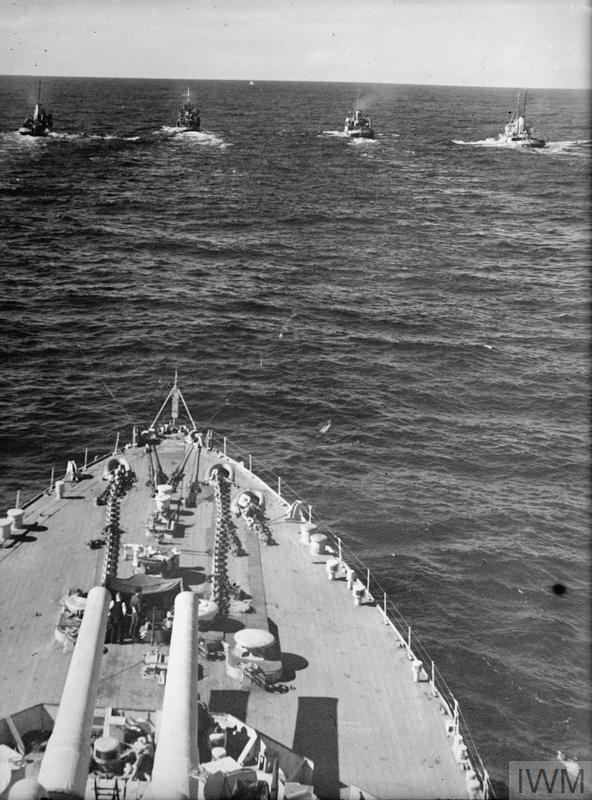
Four tugs tow Warspite to Gibraltar
However, despite all of their drawbacks, the guided bombs had frightened Allied navies. The prospect of a weapon that would allow aircraft to strike from outside the range of existing anti-aircraft guns would ultimately set in motion the development of modern naval surface-to-air missiles. But they also took more immediate steps to produce electronic countermeasures to the Kehl-Strasbourg system, which is where we will pick up our story next time.
1 There is an interesting parallel to the experience of her sister Boise, whose forward magazines were hit by a 6" Japanese shell during the Battle of Cape Esperance. They caught fire, just as the Japanese hoped, but it was also extinguished by flooding induced by the damage that started the fire. ⇑

Comments
Huh. If you were sitting in 1943 and considering invading France, you might well be thinking "amphibious invasions of a defended coast are no longer possible". Looking bad for Overlord, from my perspective. But perhaps the countermeasures you mention will be spectacularly effective? Or then again perhaps it's just a question of grinding down the Luftwaffe until they can no longer credibly threaten this sort of thing. Staying tuned...
They managed to take Salerno despite the attacks, after all, and with a force considerably smaller than the one being prepared for Overlord. And with a lot worse air cover. Even if the countermeasures had been totally ineffective, there were basically no German air attacks on the beachhead, and the ones made were the sort of low-level attacks that the guided bombs couldn't handle.
Sure, but it was the Germans' first try at using the guided bombs, and they were still clearly vastly more effective than previous air attacks on ships. They ought to have improved by 1944, not to mention mass-producing them and doing sorties of several hundred bombers, enough that they could target transports as well as warships.
I'm going to refrain from dealing with most of these points, as Part 4 goes into them in more detail. One of the big problems I will deal with was industrial resources. The bombers weren't cheap, and there were lots of other demands on German industry, so hundreds of bombers over Normandy wasn't really plausible.
So, apparently the lesson is to not ally with Italy, because if you develop a fleet-shatteringly effective secret weapon that you can only use once or twice before the enemy develops countermeasures, you have to waste the first use sinking your nominal ally's fleet as it defects to the enemy, and the second to prevent the enemy from landing unopposed on your ally's shores.
Absent Italian surrender, the Germans plausibly could have stockpiled, hoarded, and covertly tested guided bombs for a grand unveiling at Overlord. If allied battleships on the gun line start blowing up like battlecruisers at Jutland, does that make Overlord into a repeat of Gallipoli? Probably not, but I bet it hurts a lot more than losing the use of Italia and Roma.
I suspect one problem is that if they had hoarded bombs for use against the invasion, the chance is they would have been staged elsewhere. The Lufftwaffe struggled to put anything in the air on D-Day, and I suspect this was in part because of the need to keep aircraft and their facilities away from allied bombing.
Several problems here. First, the Allies had some idea of what was coming, thanks to Ultra, even before the first ones were actually used. There's even speculation that the group Egret, their first victim, was with was specially set up to record information on the bombs. There's a good chance that any guided bomber bases would have been priority targets before the invasion.
Second, how do you know Hitler would have let them be used on June 6th? I'd give even odds he'd hold them in reserve for the actual invasion at Calais, just like he did most of his Panzers. And even if the orders had gone out reasonably promptly, there's no guarantee they would have made it over the beach in time. It took a full day at Salerno, without it being a special stockpiled weapon.
Third, the air cover over Normandy was incredible. The Germans, who were trying pretty hard, managed to get one raid over the beach in daylight on June 6th. A weapon launched from heavy bombers at high altitude that then have to fly straight and level is not going to work well. (Even leaving aside the general level of allied bombing that Chuck points out.)
Fourth, there were logistical considerations. The operators needed to practice to become proficient, which was not cheap, particularly in bulk, and there were also only a limited number of bombers available.
One other consideration is that even if the Fritz X could have been deployed at D-Day, the sheer size of the invasion fleet would have necessitated massive numbers to make an appreciable dent. Not to mention the chances that any number would have been wasted on something like the HMS Centurion, an elderly battleship who was only there to be used as a breakwater. (Apparently the ex-French battleship Courbet did exactly this, being attacked by German midget subs twice after having been scuttled as a breakwater.)
Actually, it might have been even worse than that. The British had used Iron Duke, a gunnery training ship since the early 30s, and a couple of merchant ships as decoy battleships at Scapa Flow early in the war. I could totally see something similar being done deliberately to draw off Fritz-Xs.
Also, interesting about Courbet, given that I just read that section of Morison, and he didn't mention that.
In French: http://www.netmarine.net/g/dossiers/debarq1944/sabordagecourbet.htm
Sounds like it might have attracted some air attacks as well. Part of it seems to be that they kept some anti-air armament on it to help defend the harbor, I can't tell if it was manned at the time of the attacks but if it was it would certainly make the ship seem more like a valid target.
You don't need to make a material dent in the size of the invasion fleet, you just need to put the fear of God into them. Losing three old pre-dreadnoughts didn't put much of a dent in the Allied fleets off Gallipoli, but not knowing what was hiding under the water put a huge dent in the Allied commanders' resolve.
If Fritz sinks three RN or USN battleships in the first hours off Normandy, if the destroyers and transports are roughly handled Mr. Henschel, and if nobody knows why because nobody has ever seen anything like this before, does Ramsey's resolve hold? Looking at the timeline, I can see the landings at Gold, Juno, and Sword being called off and Omaha being evacuated, leaving only Utah in allied hands at the end of the day.
But this assumes the Germans are capable first of holding their guided bombs in reserve until Normandy, and then of deploying them decisively at the outset. Judging by the explicit constraints on German armored reserves and the difficulty in coordinating a conventional Luftwaffe response, this is not the way to bet. If the Dorniers with the smart bombs don't show up until the 7th, or even the afternoon of the 6th, the Allies are sufficiently committed that a decisive material edge would be needed to stop them.
And if we're assuming the Germans can somehow overcome those constraints and commit to a counterattack early on the morning of the 6th, it's not clear that they need secret weapons to stop the invasion.
That's like half the heavy bombardment force, so it's going to make a dent in someone's plans. That said, the Allies knew about the weapons from Ultra as early as July 1943, so it probably wouldn't be as shocking as you'd think. And I strongly suspect they'd have pounded those bases flat, which was a major contributor to the defeat of the guided bombs in real history.
And I also question if they could get them deployed fast enough. Even if Hitler (or whoever he delegated to) was willing to accept that this was the moment they'd finally been waiting for reasonably promptly, complex combat missions like this don't happen instantly. The ordies would have to load the bombs, the crews would need to be briefed, and you'd have to then get the planes in the air and en route to the target. Particularly given the delays and chaos caused by allied bombing, I don't see any significant force of Fritz-X/Hs 293 carriers getting over the invasion force before the afternoon, possibly earlier.